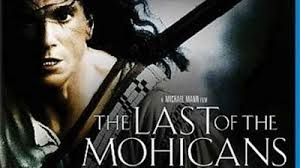To me, as of this writing, it’s simply the best movie ever made about Early American history. For pre-Civil War America, The Last of the Mohicans wins the award.

The power of this movie spans the topics that define any film. Music, directing, casting, acting, script, plot, cinematography, and message, you name it and The Last of the Mohicans exemplifies an outstanding level of achievement. My focus, however, will be on a peculiar quality of American history in the movie.
The American Revolution and the eighteenth century form the heart of my first love in the American experience. The center of that love of mine is on the story of irregular warfare, or guerrilla warfare as many folks label it today. Professional military experts, officers, and soldiers prefer to use “assymetrical warfare.” Whatever its terminology, irregular warfare emphasizes the raid, the ambush, the hit-and-run attack, among other things. It also tends to lapse into brutality, allows for a lack of uniformity, and elevates speed and intelligence (information) over nearly everything else.
Without seeking to do so, The Last of the Mohicans depicts these points and ties them together into a sort of culture or soul or way of being. That is the brilliance of the film.
The central characters are three men. Two of them are of a particular Indian tribe and a third is an adopted member of that tribe, rescued as a child during an Indian attack on a colonial village and raised as their native own. Together, these three men lead lives that are, at the same time, rooted in the distant woods yet comfortable with interacting with settlements made by British colonists.
The story unfolds by showing the rise of a North American war between France and Britain’s colonial settlers backed by their rival French and British empires anchored in Europe. Our three men side with the British and their New World colonists. They are, after all, loosely identified as British subjects as well. But you never lose sight of the fact that they are actually independent, fully capable, and of, by, and for (do these three words remind you of a famous American speech?) the life and ways of the native American woods.
You’re not entirely clear as to who they are. One of them remarks that they aren’t British Redcoats and they aren’t British colonial militia. They are, he continues, “scouts”, and have simply shown up and decided to join in the present strife. This definition is never really sharpened in the film. I’ve known some folks who’ve watched the movie and failed to deal with the lack of a clearer sense of who these three men are. For me, given my work in writing and researching so much of this type of warrior, such confusion is perfectly fine, even finely perfect.
That’s because much of their central identity is wrapped around their habit of war and war-making. The three men are skilled in tracking, hunting, hiking, and thriving in the woods, in nature. They reject and, frankly, find revolting the machine-like training and behaviour of British soldiers (Redcoats) who are required to march, fire, and fight like robots. These three men personify the world of irregular warfare as it was known then.
But they reject something else, too. Our three heroes—for that is truly the only word to use here—will not sink into the unbridled violence that so often marks irregular warfare. They won’t scalp, they won’t mutilate, they won’t torture, they won’t wallow in the worst instincts of savageness. Something stops them from doing so.
And thus for me, we arrive at the most fascinating question of the entire film: what is it that prevents this? Why do you, as the viewer, have confidence that these three men will act properly?
The answer lies in the mix, and in the mix lies a mystery.
The mix is the blend of the frontier and the woods—Nature—with the farm, the town, and the city—Civilization—and the unique result of their blend in the moment. They embody the wilderness without being wild. They are born of the bold virtues of the outdoors and age in the steadying influences of the indoors. You just know from their actions and their demeanor that they understand the presence of a right way of living and that they will, in the end, stand on that way. This blend gives them the ability to govern themselves and, hence, arrive at and exist in the unique moment of a Republic. They will triumph. Magua will die now and the Redcoats will die later.
Within the triumph, though, is the strong wind of tragedy. This is the mystery. Their lot is the wisp of sorrow, a burden carried painfully yet quietly. Their condition of blending nature and civilization does not lead to happiness as an end but instead to a constant, aggressive, and robust pursuit of happiness. The quest, the striving, is the outcome. The elusiveness of the outcome is more than the difficulty in overcoming obstacles. It’s also in the drifting sense of the outcome itself—moving, fading, vanishing.
Strangely, the mystery of the three men contains a better state of being than is often known elsewhere. They possess an energy that predates the market and market capitalism. Though such modern-sounding elements will overtake the quest and striving, they will not supplant the core of the mystery hanging over the three men. They are hunters, not tradesmen, and irregulars, not regulars, bowing on the mountaintop in tribute to their fallen kin. Only two remain.
In the movie’s final scene your eyes see a vast continent shrouded in mist and clouds. Beautiful, alluring, sinister, dangerous. The place birthed them. The place will bury them. The place will live on beyond them.







